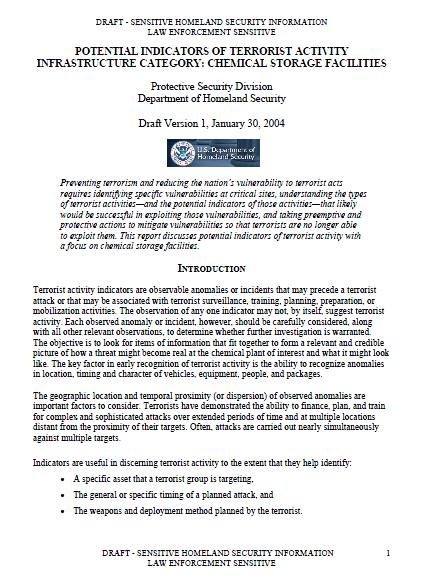POTENTIAL INDICATORS OF TERRORIST ACTIVITY INFRASTRUCTURE CATEGORY: CHEMICAL STORAGE FACILITIES
- 23 pages
- Law Enforcement Sensitive
- Sensitive Homeland Security Information
- January 30, 2004
To consider terrorist threat indicators in relationship to chemical storage facilities, it is useful to understand the basic structure of the industry and what general types of facilities might be attractive targets for terrorist attack. Chemical storage facilities are attractive terrorist targets because they can contain toxic and hazardous materials, can create extensive casualties and property damage, and can be a source of materials for use in other attacks. Figure 1 shows some of the potential terrorist targeting objectives.
Damage or destruction of the facility can be intended to inflict casualties, both on- and offsite,
shut down or degrade the operation of the facility, or cause the release of hazardous materials to
the surrounding area. Disruption of the facility without inflicting actual damage can be intended
to interfere with facility operations and cause a decrease of output or to tamper with facility
products to render them dangerous or unusable. Theft of equipment, materials, or products can
be intended to divert them to other uses or to reap financial gain from their resale. Theft of
information can be intended to acquire insight that is not made public or to gain data that can be
used in carrying out attacks. Facility attacks can be intended to (1) cause economic, national
security, or logistical harm; (2) contaminate product going into the food, medical, or health care
system; or (3) “weaponize” the facility against the surrounding human population by causing the
release of hazardous materials from the plant site.…
Sector Description
The chemical manufacturing industry produces an enormous number of materials. Government
sources estimate that 15,000 chemicals are manufactured in the United States (U.S.) in quantities
greater than 10,000 pounds (U.S. Environmental Protection Agency [EPA] 2002). The organic
chemicals industry, which manufactures carbon-containing chemicals, accounts for much of
this diversity.The North American Industry Classification System (NAICS) was developed by the statistical
agencies of Canada, Mexico, and the U.S. to provide common definitions of the industries within
the three countries and a common statistical framework for analyzing statistical data relating to
industry and the economy. It has a hierarchical structure, dividing the economy into 20 sectors at
its highest level. The general structure of the chemical storage industry by NAICS codes is
shown in Table 1. The “Other Chemical & Allied Product Wholesaler” sector handles a variety
of toxic and flammable compounds as raw materials, intermediates, or finished products. The
other two sectors in Table 1 handle either quantities of agricultural chemicals (NAICS 42291)
or incidental amounts of toxic or flammable materials (NAICS 4931).Approximately $18 billion of U.S. chemical industry sales are made through chemical
distributors, who are also actively engaged in various phases of import/export trade that
contributes significantly to the total chemical industry’s annual positive balance of trade.
Companies are largely entrepreneurial and generally service a particular geographic region and
specific industrial sector. The distributors’ industrial customers use these materials to produce an
endless list of products, including food flavorings, perfumes, water purifiers, computers, plastics,
paints and coatings, textiles, cosmetics and toiletries, detergents, automobile parts, rubber
compounds, fiberglass, pharmaceuticals, and many other products.Chemical storage facilities are among the most common areas containing either toxic or
flammable compounds with quantities sufficient to require the facility to submit a Risk
Management Plan (RMP) to the EPA. As shown in Table 2, farm suppliers’ wholesalers are the
most prevalent facility handling either toxic or hazardous materials. The most prevalent toxic
chemical processes, including refrigeration systems and fertilizer storage containers, generally
contain relatively small chemical quantities.

